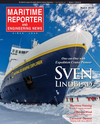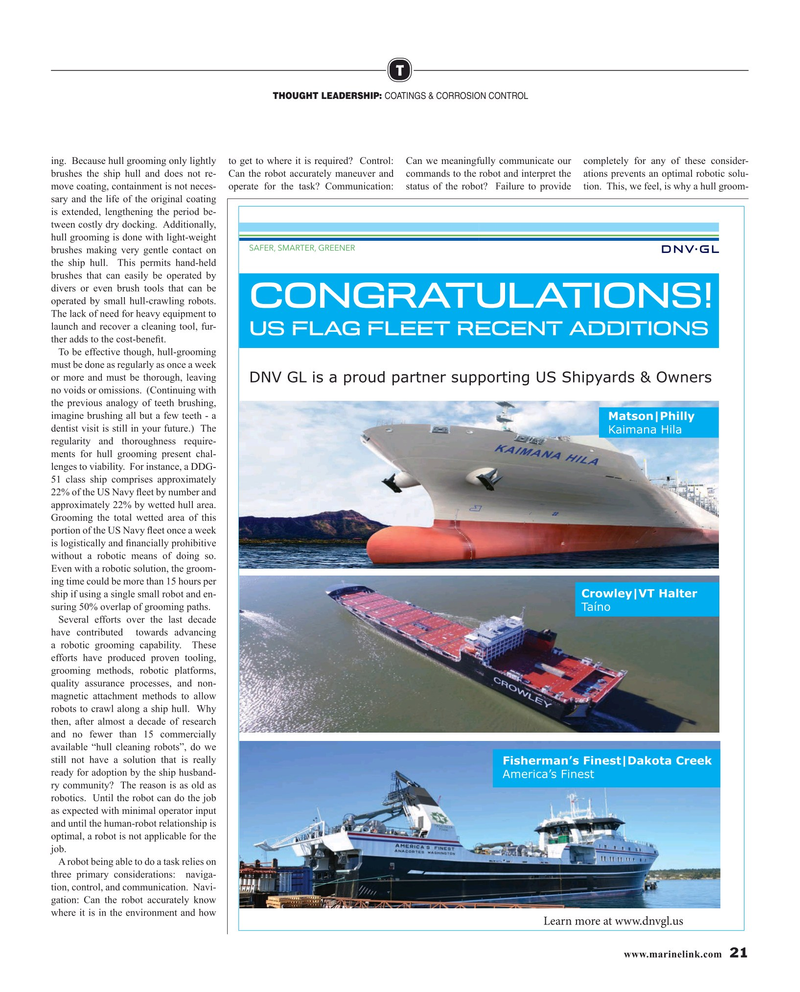
Page 21: of Maritime Reporter Magazine (March 2019)
Cruise Shipping
Read this page in Pdf, Flash or Html5 edition of March 2019 Maritime Reporter Magazine
T
THOUGHT LEADERSHIP: COATINGS & CORROSION CONTROL ing. Because hull grooming only lightly to get to where it is required? Control: Can we meaningfully communicate our completely for any of these consider- brushes the ship hull and does not re- Can the robot accurately maneuver and commands to the robot and interpret the ations prevents an optimal robotic solu- move coating, containment is not neces- operate for the task? Communication: status of the robot? Failure to provide tion. This, we feel, is why a hull groom- sary and the life of the original coating is extended, lengthening the period be- tween costly dry docking. Additionally, hull grooming is done with light-weight
SAFER, SMARTER, GREENER brushes making very gentle contact on the ship hull. This permits hand-held brushes that can easily be operated by divers or even brush tools that can be operated by small hull-crawling robots.
CONGRATULATIONS!
The lack of need for heavy equipment to launch and recover a cleaning tool, fur-
US FLAG FLEET RECENT ADDITIONS ther adds to the cost-bene? t.
To be effective though, hull-grooming must be done as regularly as once a week or more and must be thorough, leaving
DNV GL is a proud partner supporting US Shipyards & Owners no voids or omissions. (Continuing with the previous analogy of teeth brushing, imagine brushing all but a few teeth - a
Matson|Philly dentist visit is still in your future.) The
Kaimana Hila regularity and thoroughness require- ments for hull grooming present chal- lenges to viability. For instance, a DDG- 51 class ship comprises approximately 22% of the US Navy ? eet by number and approximately 22% by wetted hull area.
Grooming the total wetted area of this portion of the US Navy ? eet once a week is logistically and ? nancially prohibitive without a robotic means of doing so.
Even with a robotic solution, the groom- ing time could be more than 15 hours per ship if using a single small robot and en-
Crowley|VT Halter suring 50% overlap of grooming paths.
Taíno
Several efforts over the last decade have contributed towards advancing a robotic grooming capability. These efforts have produced proven tooling, grooming methods, robotic platforms, quality assurance processes, and non- magnetic attachment methods to allow robots to crawl along a ship hull. Why then, after almost a decade of research and no fewer than 15 commercially available “hull cleaning robots”, do we still not have a solution that is really
Fisherman’s Finest|Dakota Creek ready for adoption by the ship husband-
America’s Finest ry community? The reason is as old as robotics. Until the robot can do the job as expected with minimal operator input and until the human-robot relationship is optimal, a robot is not applicable for the job.
A robot being able to do a task relies on three primary considerations: naviga- tion, control, and communication. Navi- gation: Can the robot accurately know where it is in the environment and how
Learn more at www.dnvgl.us www.marinelink.com 21
MR #3 (18-25).indd 21 3/7/2019 4:50:00 PM

 20
20

 22
22
